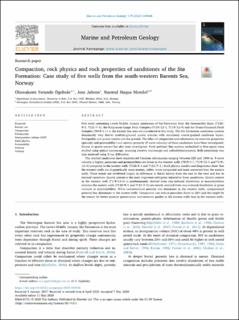| dc.contributor.author | Ogebule, Oluwakemi Yetunde | |
| dc.contributor.author | Jahren, Jens | |
| dc.contributor.author | Mondol, Nazmul Haque | |
| dc.date.accessioned | 2020-06-04T06:28:01Z | |
| dc.date.available | 2020-06-04T06:28:01Z | |
| dc.date.created | 2020-05-19T09:25:43Z | |
| dc.date.issued | 2020 | |
| dc.identifier.citation | Marine and Petroleum Geology, 119, 104448. doi: | |
| dc.identifier.issn | 0264-8172 | |
| dc.identifier.uri | https://hdl.handle.net/11250/2656446 | |
| dc.description.abstract | Five wells containing Lower-Middle Jurassic sandstones of Stø Formation from the Hammerfest Basin (7120/9–1, 7121/7–1), the Ringvassøy-Loppa Fault Complex (7119/12–1, 7119/12–4) and the Troms-Finnmark Fault Complex (7019/1-1) in the Barents Sea area are considered in this study. The Stø Formation sandstones contain dominantly very fine-to medium-grained quartz arenites with occasional coarse-grained sandstone layers. Feldspathic and quartz wackes are also present. The effect of compaction and exhumation on reservoir properties (porosity and permeability) and seismic property (P-wave velocity) of these sandstones have been investigated. Source of quartz cement has also been investigated. Forty polished thin sections embedded in blue epoxy were studied using optical microscopy, scanning electron microscopy and cathodoluminiscence. Bulk mineralogy was also analysed using X-ray diffraction. The studied sandstones have experienced Cenozoic exhumation ranging between 820 and 1050 m. P-wave velocity is higher; porosities and permeabilities are lower in the western wells (7019/1-1, 7119/12–1 and 7119/12–4) compared to the eastern wells (7120/9–1 and 7121/7–1). Rock physics models and diagnostics show that the western wells are diagenetically more mature, stiffer, more compacted and more cemented than the eastern wells. These trends are attributed largely to difference in burial history from the east to the west and less to textural variations. Quartz cement is the most important authigenic mineral in these sandstones. Quartz cement in the western well (7119/12–1) is predominantly derived from clay-induced dissolution at macrostylolites whereas the eastern wells (7120/9–1 and 7121/7–1) are mostly sourced from clay-induced dissolution at grain contacts or microstylolites. While cementational porosity loss dominates in the western wells, compactional porosity loss dominates in the eastern wells. Compaction can reduce porosities down to 26% and this might be the reason for better porosity preservation and reservoir quality in the eastern wells than in the western wells. | |
| dc.language.iso | eng | |
| dc.title | Compaction, rock physics and rock properties of sandstones of the Stø Formation: Case study of five wells from the south-western Barents Sea, Norway | |
| dc.type | Peer reviewed | |
| dc.type | Journal article | |
| dc.description.version | publishedVersion | |
| dc.source.volume | 119 | |
| dc.source.journal | Marine and Petroleum Geology | |
| dc.identifier.doi | 10.1016/j.marpetgeo.2020.104448 | |
| dc.identifier.cristin | 1811632 | |
| cristin.ispublished | true | |
| cristin.fulltext | original | |
| cristin.qualitycode | 1 | |
